When you think of Indonesia, an archipelago of over 17,000 islands, vibrant cultures, diverse traditions, and an array of stunning landscapes come to mind. That said, one of the most captivating aspects of this vast nation is its traditional Indonesian clothing, each piece telling a unique story from its province of origin. There’s over 1,300 ethnic groups in Indonesia, all with their own fashion style; some are quite similar, while others are distinctly unique. Now, although we would love to explore them all, delving into over a thousand pieces would be too lengthy a journey, so let’s see the ones that represent each of the 38 provinces of Indonesia, from the westernmost to easternmost.
Traditional Indonesian clothing is a vibrant and diverse reflection of the country’s rich cultural heritage. Each piece of attire tells a unique story from its province of origin.
Originating from the ancient Muslim kingdom of Samudra Pasai, this clothing was reserved for royalty and nobility, symbolizing status and honor within Acehnese society. Today, it is worn during significant cultural ceremonies and celebrations, such as weddings. There are two versions of Ulee Balang: Linto Baro for men and Daro Baro for women. The style of this clothing is closely influenced by Muslim and Malay culture, featuring elements like the sarong songket and a high headpiece for men, and a loose tunic adorned with floral and leaf patterns for women.
Ulee Balang was worn by royalty and nobility in the Aceh Sultanate, symbolizing status and honor.
The clothing features elements like the sarong songket and a high headpiece for men, and a loose tunic adorned with floral and leaf patterns for women.
Today, it is worn during significant cultural ceremonies and celebrations such as weddings.
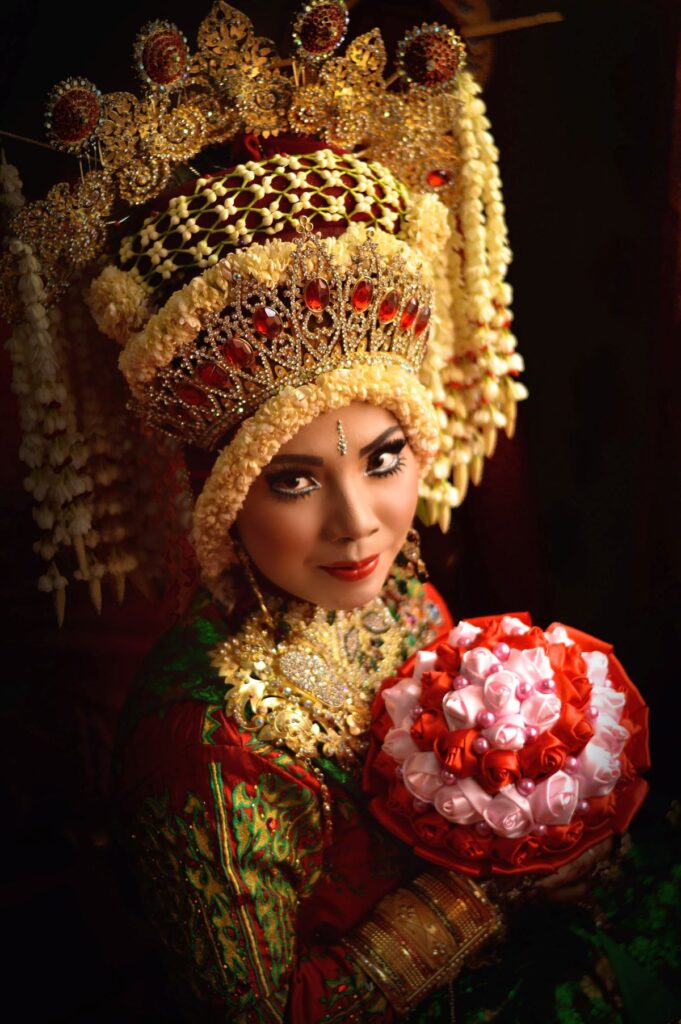
Bundo Kanduang, literally translated into ‘birth mother’, is a traditional dress from West Sumatra, notable for its bright colors and intricate designs influenced by Malay, Arab, and Chinese cultures. The most distinctive feature of Bundo Kanduang is it’s headpiece resembling the roof of a traditional house, symbolizing the central role of women in the family.
Bundo Kanduang represents the matrilineal society of the Minangkabau, highlighting women’s central role in the family.
Influenced by Malay, Arab, and Chinese cultures, the most distinctive feature is its headpiece resembling the roof of a traditional house.
This attire is prominent during cultural festivals and traditional weddings.
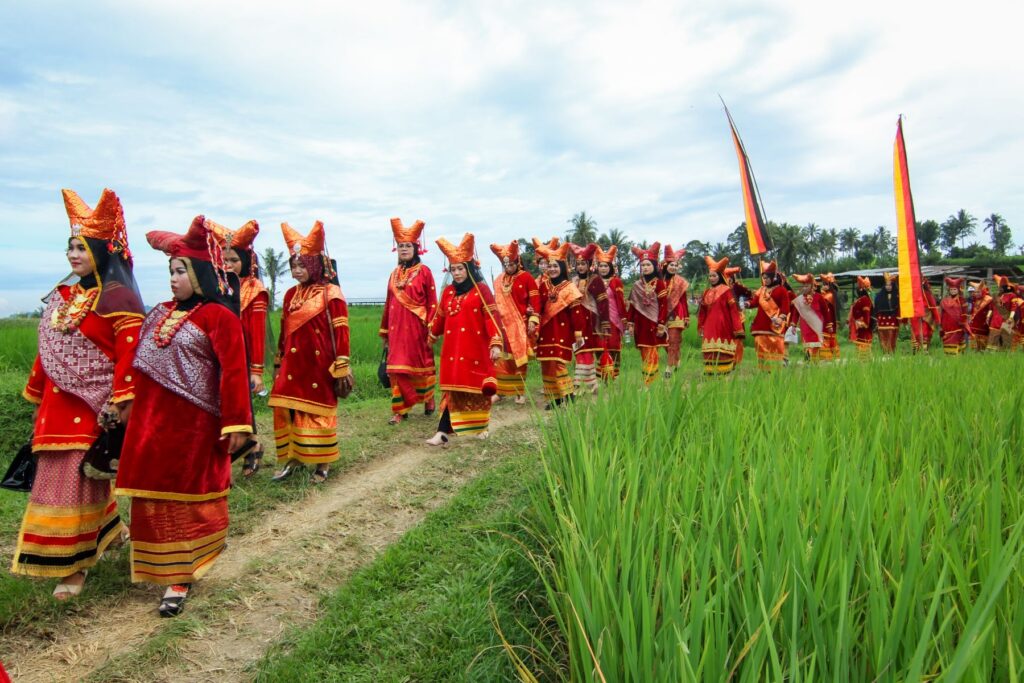
Initially used as a warm wrap in the cool highland climate, ulos has evolved into a symbol of love, unity, and blessings within the Batak community. The intricate weaving of ulos, often featuring vibrant colors and detailed patterns, represents various aspects of life and social status. For instance, the Ulos Ragidup symbolizes longevity and prosperity, while the Ulos Ragi Hotang is often gifted to newlyweds to signify a strong marital bond. The tradition of mangulosi—the ceremonial draping of ulos—underscores its importance in expressing affection and respect during significant life events such as weddings and births.
Ulos, a traditional Batak cloth, symbolizes love, unity, and blessings during significant life events.
The intricate weaving often features vibrant colors and detailed patterns, each representing various aspects of life and social status.
The tradition of mangulosi, the ceremonial draping of Ulos, underscores its importance during significant life events such as weddings and births.
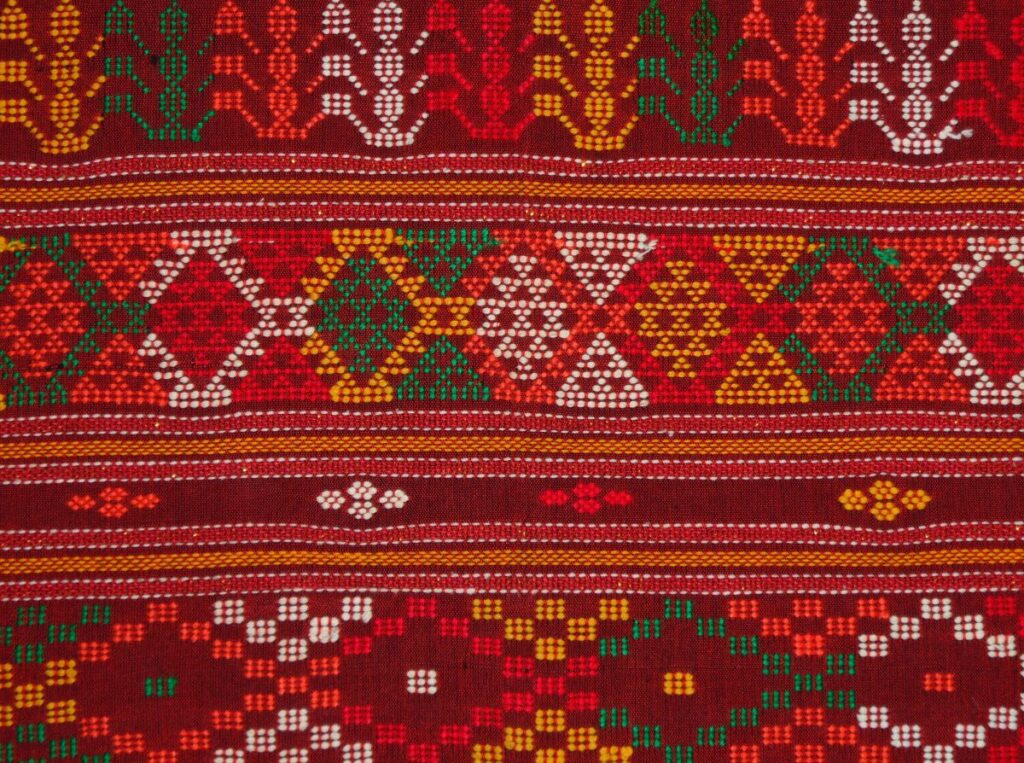
Named in connection with Sumatra’s ancient moniker, Suwarna-dwipa (meaning ‘island of gold’), Aesan Gede features gold-themed accessories. Historically worn by nobility, this songket fabric attire is adorned during wedding ceremonies, symbolizing the grandeur of the wearer. It is particularly significant in the “munggah” ceremony, a pivotal part of the traditional wedding rites. Aesan Gede’s design also incorporates elements from the Hindu-Buddhist traditions of the Sriwijaya Kingdom.
Aesan Gede, adorned with gold threads, reflects the historical grandeur and cultural sophistication of the Sriwijaya Empire.
This songket fabric attire is adorned with gold-themed accessories.
It is particularly significant in the “munggah” ceremony, a pivotal part of traditional wedding rites.
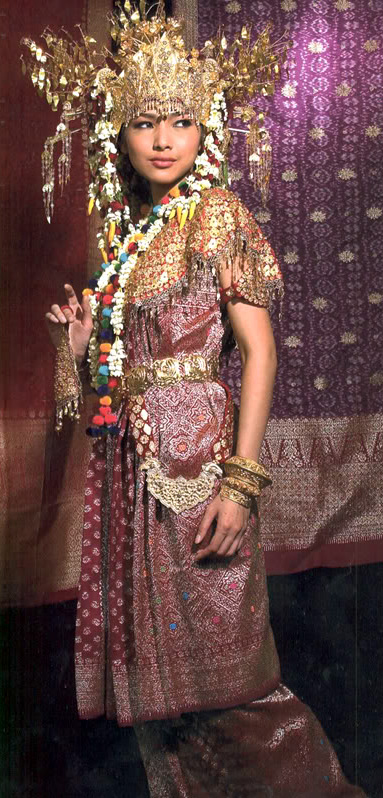
These two province share a very similar (if not almost the same) culture, including its traditional attire. Kebaya Labuh and Teluk Belangga are traditional attires from the Riau and Riau Islands, Indonesia, reflecting the rich cultural heritage of the Malay community. The Kebaya Labuh is a long kebaya extending to the knees, commonly paired with batik or songket skirts, and adorned with intricate embroidery. It is typically worn by women during formal events and weddings. The Teluk Belangga, worn by men, consists of a long-sleeved shirt, matching trousers, and a headpiece called tanjak, often used in official ceremonies and embodying Islamic values and Malay traditions.
Teluk Belanga and Kebaya Labuh embody the rich cultural heritage and Islamic values of the Malay community in Riau.
The Kebaya Labuh is paired with batik or songket skirts, while Teluk Belanga for men includes a long-sleeved shirt and matching trousers.
These garments are typically worn during formal events and weddings.
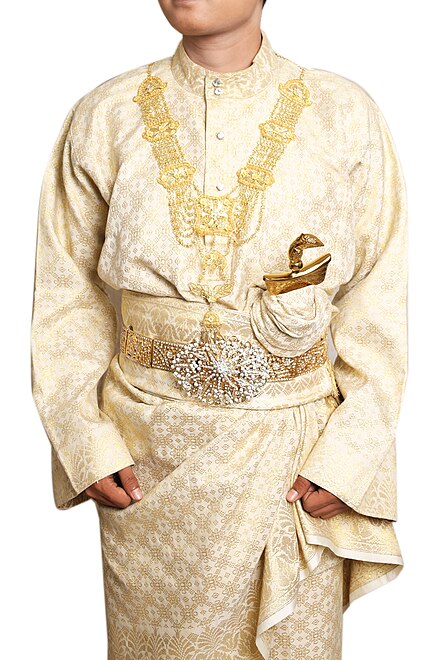
This traditional outfit is made from velvet, typically in red, adorned with intricate gold embroidery featuring floral patterns such as tagapo, jasmine, and other flower motifs. Baju Kurung is worn by both men and women during formal events and weddings, the men’s attire includes cangge (pants) and a lacak (velvet headpiece) reinforced with paper to stand upright, often accompanied by a keris (traditional dagger). The women’s version is paired with songket skirts and accessorized with teratai dada (a lotus-shaped chest covering), long necklaces, bracelets, and distinctive telukuk headpieces, usually made from gold or gold-plated materials, showcasing the elegance and cultural heritage of the attire.
Baju Kurung, influenced by Malay culture, symbolizes elegance and social status with its intricate gold embroidery.
Baju Kurung is made from velvet, typically in red, adorned with intricate gold embroidery.
Both men and women wear Baju Kurung during formal events and weddings.
Paksian is a traditional bridal attire from Bangka Belitung, known for its rich cultural significance and distinct design influenced by Chinese and Arab cultures. Typically worn during weddings, Paksian consists of a blouse, skirt, and shawl, often in red and gold colors symbolizing prosperity and elegance. The ensemble includes elaborate headpieces and accessories that enhance its ceremonial grandeur.
Paksian, influenced by Chinese and Arab cultures, is a traditional bridal attire symbolizing prosperity and elegance.
The attire is elaborate, including headpieces and accessories that enhance its ceremonial grandeur.
Typically worn during weddings.
The Rejang Lebong tribe, found in various regions of Bengkulu, is renowned for its distinctive traditional attire. The bridal wear for women includes a flower and powder adornment, a sequined blouse, embroidered gold thread skirt, and black sandals. Additionally, they wear peacock feather headpieces and lotus-shaped shoulder decorations, along with necklaces, waist pendants, and keroncong bracelets. Men wear white shirts, black jackets with gold chains, gold-embroidered shawls, and songket fabric belts, often holding a keris. Both bride and groom wear traditional shoes or sandals.
Rejang Lebong’s bridal attire, adorned with peacock feathers and gold embellishments, reflects the tribe’s rich artistic heritage.
Men wear white shirts with black jackets, gold chains, and songket fabric belts.
The attire is worn during significant cultural and traditional wedding ceremonies.
The traditional attire from Lampung, known as Tulang Bawang, reflects the region’s rich cultural heritage. It features intricate designs with elaborate gold and silver thread embroidery, symbolizing prosperity and beauty. Both men and women wear accessories such as necklaces, bracelets, and headpieces that highlight the traditional craftsmanship. The attire is often worn during important ceremonies and cultural events, showcasing the pride and identity of the Lampung people.
Tulang Bawang features elaborate embroidery with gold and silver threads, symbolizing the artistic heritage of Lampung.
Accessories such as necklaces, bracelets, and headpieces highlight the traditional craftsmanship.
The attire is often worn during important ceremonies and cultural events.
Pangsi is characterized by its loose-fitting design, allowing for ease of movement. It is typically made from black or dark-colored fabric and includes a long-sleeved shirt and wide pants, often worn with a belt or sash. This outfit is commonly associated with martial arts practitioners and traditional ceremonies, reflecting the cultural heritage and simplicity of the Bantenese people.
Pangsi is associated with Bantenese martial arts, reflecting cultural heritage and simplicity.
Made from black or dark-colored fabric, it includes a long-sleeved shirt and wide pants.
This outfit is commonly associated with martial arts practitioners and traditional ceremonies.
Jakarta, the port city of Indonesia, bringing various ethnic group together and merging the culture into something new and vibrant. The Betawi traditional attire, Baju Sadariah and Kebaya Encim, reflects this cultural assimilation. Baju Sadariah, worn by men, is typically a loose-fitting shirt paired with trousers and a headgear called peci. Women wear Kebaya Encim, a long-sleeved blouse with intricate embroidery, often paired with a sarong or batik skirt. These garments symbolize the fusion of Betawi culture with Chinese, Arab, and Dutch influences, highlighting the diverse history of Jakarta.
Baju Sadariah and Kebaya Encim represent Jakarta’s cultural assimilation of Chinese, Arab, and Dutch influences.
Baju Sadariah is a loose-fitting shirt paired with trousers, while Kebaya Encim is a long-sleeved blouse with intricate embroidery.
These garments are worn during cultural festivals and traditional ceremonies.
Baju Bedahan is traditional attire from West Java, worn by middle-class Sundanese men. This white shirt, resembling a jacket with a collar, is paired with batik cloth, a belt, a headpiece, gold chain watch, and traditional footwear. Historically, it was worn by civil servants during Dutch colonial rule. In contrast, Sundanese women wear Kebaya Sunda, a long blouse with a U-shaped collar, extending over the hips and thighs, often in bright colors like red, light purple, or white, suitable for various social strata.
Baju Bedahan and Kebaya Sunda reflect the cultural heritage and social status within Sundanese society during the Dutch colonial period.
The white shirt is paired with batik cloth, a belt, a headpiece, and traditional footwear.
Kebaya Sunda is worn by women for various social events and ceremonies.
Central Java is the birthplace of batik art, which is a central element of its traditional attire. The origins of this clothing can be traced back to the ancient Mataram Kingdom, one of them is Basahan. The Basahan attire is often worn by brides and grooms during weddings. The distinctive feature is the lack of upper body clothing, with men wearing a luxurious necklace and a dodot cloth covering the lower body adorned with a keris (traditional blade), while women wear a kemben and dodot. The attire includes elaborate headpieces, beautiful necklaces, and arm decorations. The philosophy behind Basahan signifies surrender to God, hoping for a harmonious and prosperous married life.
Basahan, rooted in the ancient Mataram Kingdom, symbolizes purity and surrender to God in Javanese weddings.
Men wear luxurious necklaces and dodot cloth, while women wear kemben and dodot with elaborate headpieces.
Basahan attire can be traced back to the ancient Mataram Kingdom and is worn by brides and grooms during weddings.
Kesatrian Ageng is a traditional Yogyakarta attire for male palace officials, consisting of a black velvet laken jacket adorned with keris and batik motifs, and golden edges. The black trousers complement the jacket, while a batik cloth is wrapped around the waist, ending above the knees. The outfit is completed with various accessories and a headpiece. This attire symbolizes elegance and bravery and must be maintained according to palace regulations.
Ksatrian Ageng is a traditional attire for male palace officials in Yogyakarta, symbolizing elegance and bravery.
The black velvet laken jacket is adorned with keris and batik motifs with golden edges.
This attire symbolizes elegance and bravery, maintained according to palace regulations.
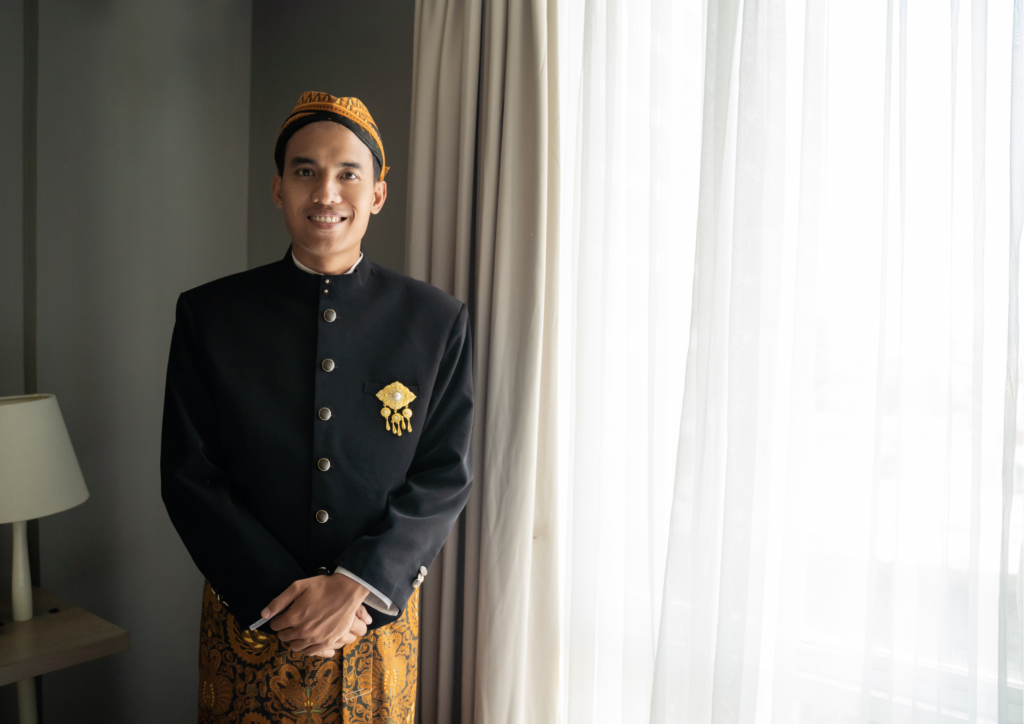
Predating from same kingdom, Central and East Java region often shares very similar culture, including its traditional attire. The highlight of East Java is, however, from the island of Madura. The traditional Madurese attire, Pesa’an, is notable for its cultural significance and simplicity, often worn for special occasions in East Java. This attire features long-sleeved, loose cotton shirts without functional buttons, paired with gomboran pants, plekat sarongs, and terompah sandals. Men often carry a celurit (sickle) as part of the ensemble. Women wear Kebaya Rancongan, a form-fitting brocade or cotton kebaya with floral or plain patterns and decorative chest details. The overall look emphasizes practicality and cultural heritage, blending comfort with tradition.
Pese’an and Kebaya Rancongan highlight the cultural heritage and simplicity of Madura in East Java.
Pese’an features long-sleeved loose cotton shirts and plekat sarongs, while Kebaya Rancongan is a form-fitting brocade or cotton kebaya.
These garments are worn during special occasions in East Java.
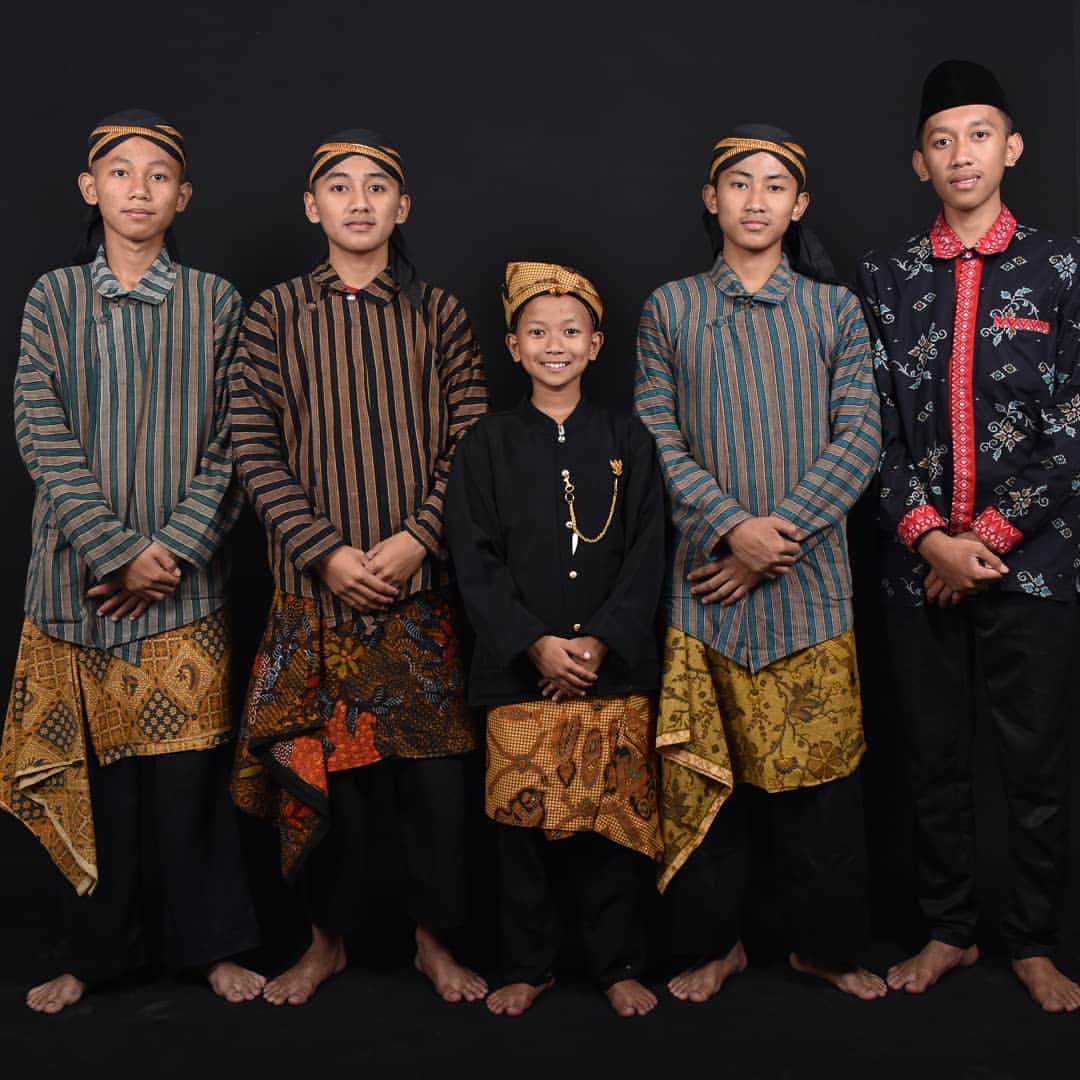
Like every other region, Bali has several different traditional attire for different occasion, but the most special one probably is Payas Agung. Payas Agung is worn during weddings or tooth-filing ceremonies, signifying luxury and special occasions. The outfit features a high crown and colorful fabric worn by the bride, including a long wrap called tapih from chest to toes, layered with kemben and kamen prada extending to the ankles. The bride also wears a srinata, a symmetrical forehead decoration, and a crown adorned with sandat and gold flowers. Accessories include a shoulder bracelet and a waist belt.
Payas Agung, worn during weddings and ceremonies, signifies luxury and Bali’s rich cultural heritage.
The outfit includes a high crown and colorful fabric with accessories like a shoulder bracelet and a waist belt.
The attire is reserved for significant cultural and ceremonial events.
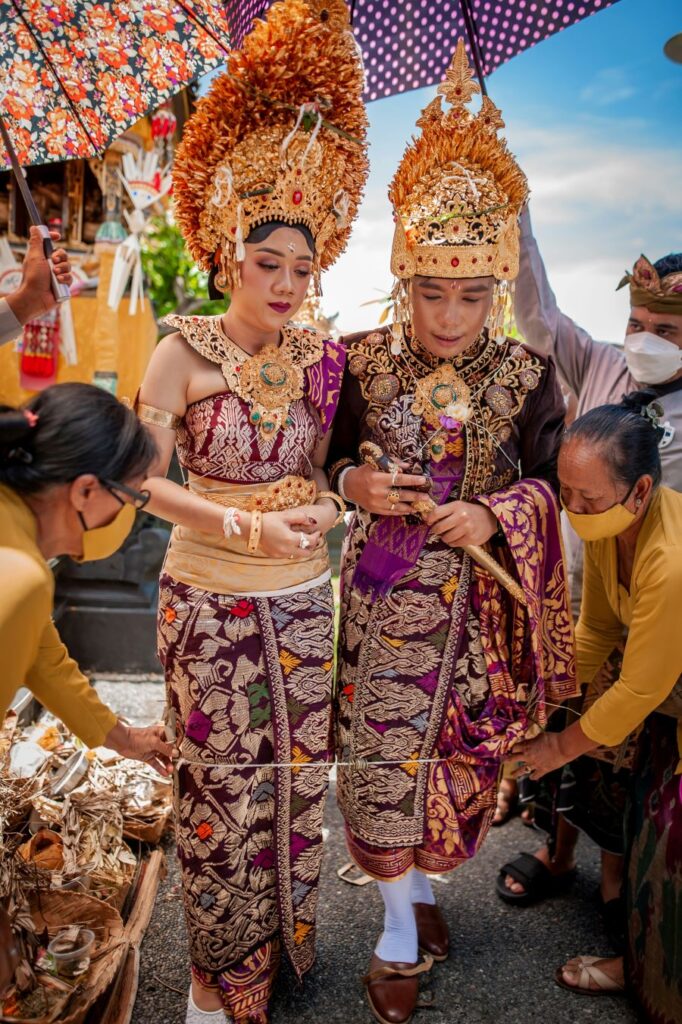
Moving to Borneo Island, we have King Baba and King Bibinge from Dayak Tribe of West Borneo. King Baba is traditional attire for Dayak men, made from flattened tree bark, specifically from the ampuro or kapuo trees. The name “King Baba” comes from the Dayak language, where “king” means clothing and “baba” means man. The bark is soaked, beaten to extract fibers, dried, and painted with ethnic Dayak patterns using natural dyes. Accessories include a headband adorned with Enggang Gading bird feathers and a traditional weapon, the mandau. King Bibinge, the female counterpart, is similarly made but more modest, with additional chest coverings, beaded decorations, and accessories like bracelets and necklaces made from roots and animal bones. Both attires are sleeveless and feature unique Dayak designs, emphasizing the use of natural materials.
King Baba and King Bibinge, made from tree bark, reflect the Dayak people’s connection to nature and traditional craftsmanship.
Made from flattened tree bark, the attire is adorned with ethnic Dayak patterns using natural dyes.
Both attires are sleeveless and feature unique designs, emphasizing the use of natural materials.
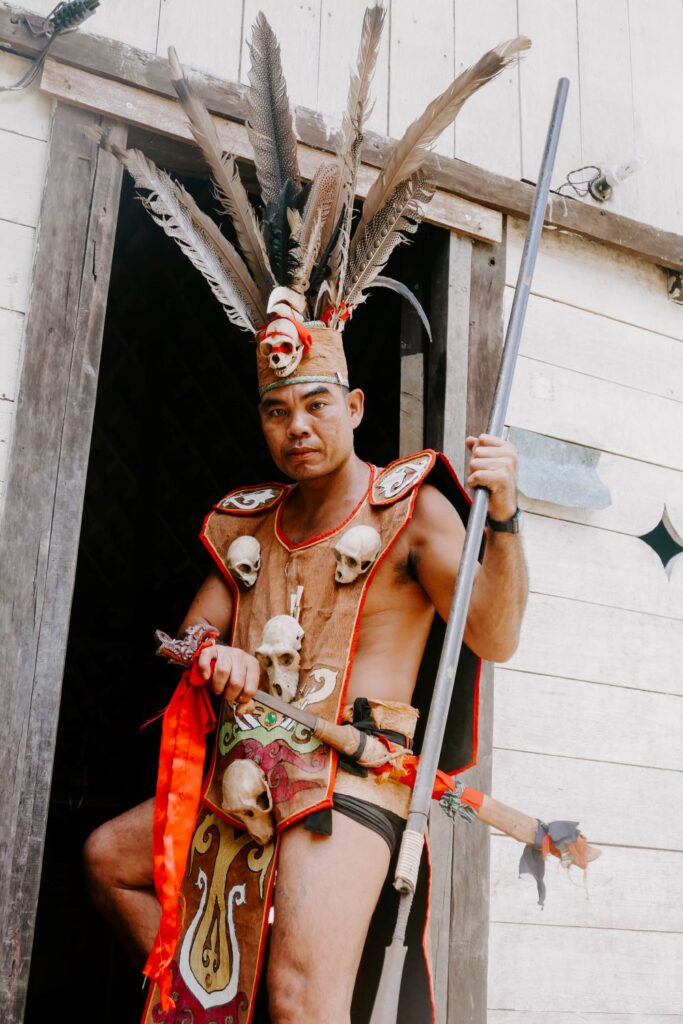
As the majority inhabitants of Borneo, the Dayak Tribe greatly influences the culture across the island, including traditional attire. Ta’a and Sapei Sapaq are traditional garments of North Kalimantan’s Dayak people. Ta’a, worn by women, includes a sleeveless velvet vest and matching skirt adorned with beads and feathers, symbolizing social status through specific motifs. Sapei Sapaq, for men, features short pants called abet kaboq, a vest, and accessories such as the mandau (traditional sword) and animal-tooth necklaces. Both attires use colors and designs that reflect cultural meanings, such as purity and strength.
Ta’a and Sapei Sapaq, adorned with beadwork, symbolize social status and cultural identity among the Dayak people.
Ta’a includes a sleeveless velvet vest and matching skirt, while Sapei Sapaq features short pants and a vest
These attires are worn during traditional ceremonies and rituals.
The Sangkarut vest is a traditional garment worn by Dayak Ngaju men from Central Borneo, featuring distinctive beadwork and traditional motifs that reflect the tribe’s cultural heritage. Made from bark or woven fabric, the vest is often adorned with intricate patterns symbolizing strength, bravery, and nature. It is primarily worn during traditional ceremonies, rituals, and important community events, highlighting the wearer’s status and role within the tribe. Accessories like necklaces made from animal teeth or bones often accompany the vest, further emphasizing the rich cultural identity of the Dayak Ngaju people.
The Sangkarut vest, with its beadwork and traditional motifs, symbolizes strength and cultural heritage among the Dayak Ngaju.
Made from bark or woven fabric, the vest is adorned with intricate patterns.
It is primarily worn during traditional ceremonies and community events.
Shifting gears from the Dayak tribe, the traditional attire of South Borneo coming from the Banjar Tribe. Babaju Kun Galung Pacinan is a traditional attire from the Banjar tribe in South Borneo, known for its bright colors and intricate patterns influenced by Chinese culture. This outfit includes a long shirt and trousers, often embroidered with detailed motifs. The name “Pacinan” reflects the historical Chinese trade connections in the region. Typically, the attire is worn during traditional ceremonies and cultural events, symbolizing the rich heritage and cultural fusion of the Banjar people.
Babajun Kun Kalung Pacinan reflects the cultural fusion and rich heritage of the Banjar people, influenced by Chinese trade connections.
The outfit includes a long shirt and trousers embroidered with detailed motifs.
The attire is worn during traditional ceremonies and cultural events.
Kustin is a traditional attire originates from the ancient kingdom of Kutai that still worn to this day by Kutai Tribe. Made from black velvet, it features intricate gold embroidery called pasmen. The women’s version includes a long shirt paired with a sarong, and is adorned with Tapeh Berumbai and a wapen-shaped chest ornament. Men’s Baju Kustin includes a long-sleeved shirt and black trousers, complemented with a dodot rambut, and a Setorong headpiece with feathers and gold decorations. Both attires reflect elegance and cultural heritage.
Kustin, from the Kutai tribe, symbolizes elegance and cultural heritage.
Made from black velvet, it features intricate gold embroidery called pasmen.
The attire is worn during significant cultural ceremonies and events.
Mukuta and Biliu are traditional wedding attires of the Gorontalo people, reflecting a blend of cultural and Islamic influences. The Mukuta for men includes a laapia bantali sibi headpiece resembling bird feathers, symbolizing leadership and gentleness. Men also wear a bako necklace signifying marital commitment and a pasimeni decoration representing household harmony. Biliu for women is more elaborate with accessories like the baya lo boute headband, tuhi-tuhi headpiece with seven pendants symbolizing ties between seven kingdoms, and a lai-lai headpiece symbolizing noble character and purity. The attire is commonly seen at weddings and cultural events like the Saronde Festival, which has national recognition.
Biliu and Makuta, reflect the blend of cultural and Islamic influences in Gorontalo weddings, symbolizing leadership, marital commitment, and noble character.
The attire includes elaborate accessories.
Commonly seen at weddings and cultural events like the Saronde Festival.
Pattuqduq Towaine is a traditional dress from the Mandar tribe in West Sulawesi, primarily worn by women during the Pattuqduq traditional dance. The outfit is made from bright, colorful fabrics and is adorned with intricate embroidery and accessories that highlight the wearer’s elegance and grace. The attire reflects the rich cultural heritage of the Mandar people and is an integral part of their ceremonial attire, especially during cultural and festive events.
Pattuqduq Towaine, highlights the elegance and cultural heritage of the Mandar people.
Made from bright colorful fabrics, adorned with intricate embroidery and accessories.
Pattuqduq Towaine is worn by women during the Pattuqduq traditional dance.
The traditional clothing from Central Sulawesi coming from Kaili Tribe. Nggembe is traditional attire for Kaili women in Central Sulawesi, typically worn at cultural events and ceremonies. This loose, round-collared garment with short sleeves is complemented by additional accessories such as sampo dada, dali taroe (long earrings), gemo (necklace), ponto date (long bracelet), and a pende (belt made of gold or silver). The outfit is completed with a Buya Sabe Kumbaja sarong. Predominant colors include red, yellow, and black, but other colors like white, green, and purple are also used.
Nggembe, worn by Kaili women, reflects the cultural heritage and artistic skills of Central Sulawesi.
The loose round-collared garment is complemented by accessories like long earrings and bracelets.
The attire is worn at cultural events and ceremonies.
From the Minahasa people, we have Laku Tepu in North Sulawesi. This clothing is made from woven fibers of the pandanus plant and is usually worn during traditional ceremonies and rituals. The outfit consists of a woven top and a sarong, complemented by accessories such as beaded necklaces and traditional headgear. The Laku Tepu attire reflects the cultural heritage and craftsmanship of the Minahasa people, symbolizing their connection to nature and tradition.
Laku Tepu, made from woven pandanus fibers, symbolizes the Minahasa’s connection to nature and tradition.
Laku Tepu is made from woven fibers of the pandanus plant.
The attire is worn during traditional ceremonies and rituals.
Babu Nggawi is the traditional attire of the Tolaki tribe in Southeast Sulawesi. This clothing is often worn during traditional ceremonies, reflecting the cultural heritage of the Tolaki people. Babu Nggawi attire includes elements such as colorful sarongs, intricately designed blouses, and various accessories that showcase the tribe’s unique aesthetic and craftsmanship. The vibrant colors and detailed patterns symbolize the rich cultural identity and artistic skills of the Tolaki community.
Babu Nggawi, reflects the cultural heritage and vibrant identity of the Tolaki tribe.
The clothing includes colorful sarongs, intricately designed blouses, and various accessories.
Worn during traditional ceremonies.
Lastly from Sulawesi, the next traditional attire coming from Bugis and Toraja Tribe. Baju Bodo is a traditional attire from South Sulawesi, specifically from the Bugis tribe, and is considered one of the oldest traditional garments in the world. Originally made from sheer fabric, it was later adapted to thicker materials with the advent of Islam. Baju Bodo is known for its rectangular shape with short sleeves and various colors indicating the wearer’s age and status: green for nobility, white for shamans or servants, purple for widows, orange for girls aged 10, and red for 17-year-olds. The attire is usually paired with a checkered sarong and adorned with accessories like rings, gold bands, bracelets, and metal pieces, often made from gold-plated materials or metal. The design ensures comfort, with loose fit and wide-weave fabric. Baju Pokko, another traditional garment from South Sulawesi, comes from the Toraja tribe. It features short sleeves and bright colors such as yellow, red, and white, often worn with jewelry and beads, and accessories like headbands and belts called kandure. Baju Pokko is typically reserved for formal events.
Baju Bodo and Baju Pokko represent the Bugis and Toraja tribes, highlighting their cultural heritage and social status.
The attire includes short sleeves and various colors indicating the wearer’s age and status.
Baju Pokko from the Toraja tribe is reserved for formal events and adorned with jewelry and beads.
Lambung and Pegon are traditional attires of the Sasak tribe from Lombok, West Nusa Tenggara. Lambung, worn by women, is a sleeveless, black V-neck dress paired with a shoulder shawl and sarong, often decorated with silver accessories. Pegon, for men, combines Javanese and European influences, featuring a jacket, sarong, and a headpiece called Cappuq. These garments are worn during traditional ceremonies and festivals, reflecting the rich cultural heritage of the Sasak people.
Lambung, traditional attire of the Sasak tribe, reflects the cultural heritage and ceremonial significance of West Nusa Tenggara.
The sleeveless black V-neck dress is paired with a shoulder shawl and sarong.
Worn during traditional ceremonies and festivals.
Nusa Tenggara is a region of Indonesia consisting of an archipelago of islands, resulting in the birth of various tribes, each with a unique and distinct culture. For Sumba men, traditional attire includes an ikat headpiece called Tiara Patang, which can be styled in various ways to signify different symbols. They also wear traditional weapons, Kabiala, at their waist, symbolizing strength. Jewelry like Muti Salak and Kanatar on the left wrist indicates social and economic status. Sumba women wear different types of cloth like Lau Kawar and Lau Pahudu, covering from the chest to shoulders with matching Taba Huku. Accessories include a Tiara, metal forehead jewelry (Maraga), Mamuli earrings, and gold necklaces. Traditional Sumba attire is worn during significant ceremonies and celebrations.
Hinggi, featuring ikat weaving, symbolizes social status and cultural traditions in Sumba.
Men wear traditional weapons, while women wear various types of cloth with accessories.
Worn during significant ceremonies and celebrations.
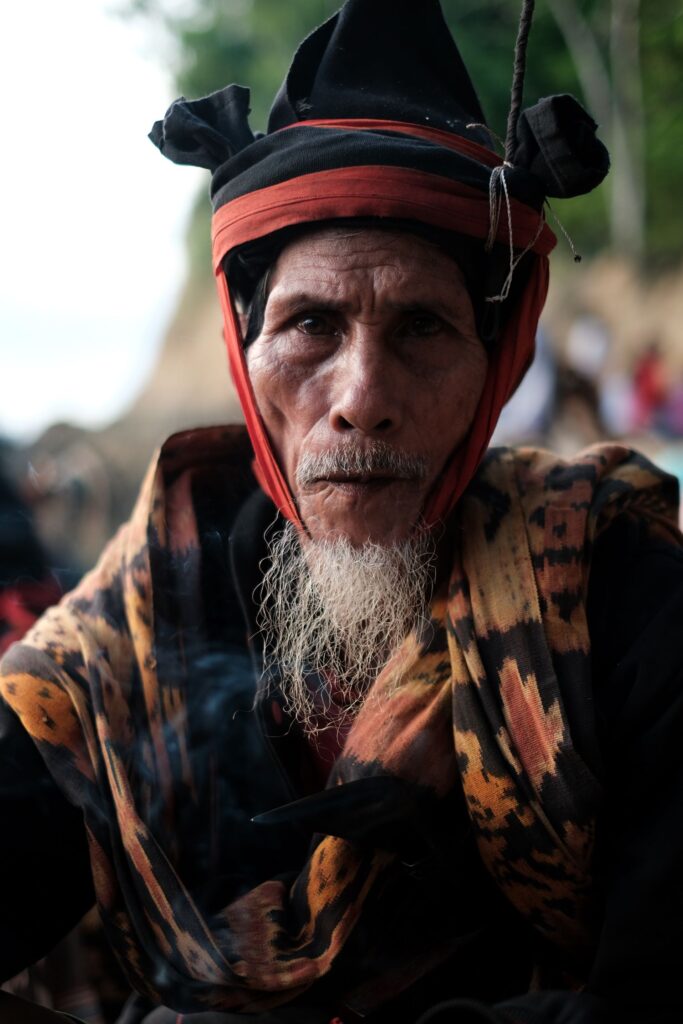
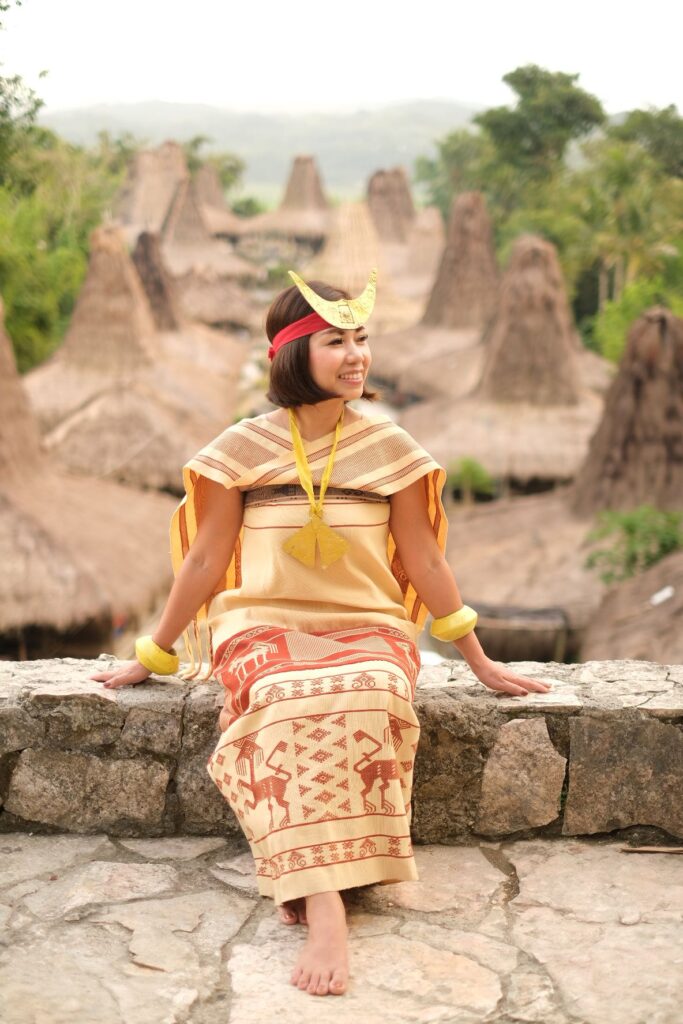
Baju Cele is a traditional Ambonese attire from Maluku, characterized by its kurung-like design (traditional Southeast Asian clothing characterized by its loose, comfortable fit) extending to mid-hip, often paired with a matching sarong called kain salele. The outfit typically features geometric stripes or small checks and is commonly red, symbolizing joy and agility. Accessories include a sanggul or konde bulan reinforced with haspel pins made of gold or silver. This attire is worn during significant events like adat ceremonies, royal inaugurations, and festivals.
Baju Cele, with its geometric patterns, reflects the cultural heritage and identity of Ambon in Maluku.
Often red, symbolizing joy and agility, with accessories like sanggul or konde bulan.
Worn during adat ceremonies, royal inaugurations, and festivals.
Manteren Lamo is traditional attire for men in North Maluku tracing back from the Maluku Sultanese, featuring a closed red jacket symbolizing bravery. The jacket is adorned with large silver buttons, typically nine in number, and gold embroidery on the cuffs, collar, and pockets. This attire, once worn by the sultanate, is paired with black pants and includes a headpiece, reflecting its luxurious heritage.
Manteren Lamo, from the Maluku Sultanate, symbolizes bravery and luxury.
The jacket is adorned with large silver buttons and gold embroidery.
Worn during significant cultural and ceremonial events.
From Papua, we have quite an unique attire called Koteka, which, basically, a covering for male genital. The term comes from the Mee language, meaning clothing, and is called holim in the Dani language. Made from bird beak casings and gourd skins, the koteka’s design varies by status and tribe. For example, Dani leaders wear differently shaped kotekas to signify their rank. The Yali tribe prefers long gourds for their humi, while the Lani tribe uses two gourds for their kobeba. Each design signifies the wearer’s status within the community.
Koteka, worn by men in Papua, designs signify the wearer’s status within the community and reflects the unique cultural practices and identity of Papuan tribes.
Made from bird beak casings and gourd skins.
Koteka is a covering for male genital, varying by status and tribe.
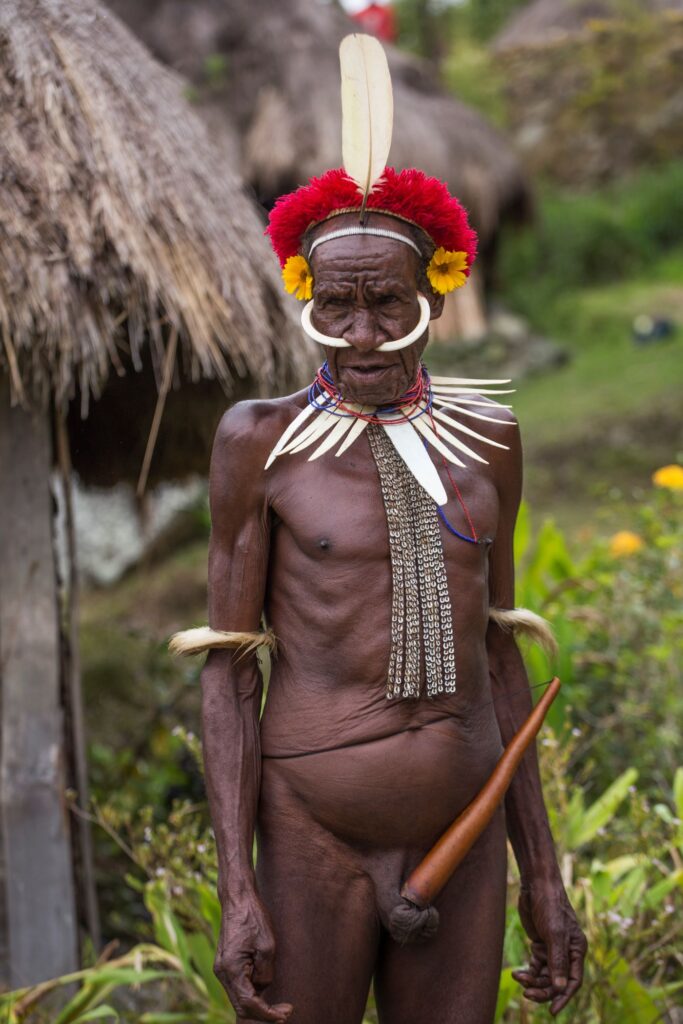
Moving to West Papua, the next traditional attire is Ewer. Traditionally, men wore Ewer skirts made from dried straw around their waist, while women wore both a top and a straw skirt. Over time, modern Ewer attire for both men and women has incorporated fabric tops, blending natural materials with cloth. This attire is often worn during traditional ceremonies and formal events, complemented by distinctive headpieces with West Papuan motifs.
Ewer skirts, symbolize the cultural heritage and traditional attire of West Papua.
Ewer skirts are made from dried straw.
Worn during traditional ceremonies and formal events.
Pummi is a traditional attire from South Papua, featuring a mini skirt made from woven sago leaves. The skirt’s fringes are left loose, draping around the hips and thighs. The designs for men and women differ, with men typically wearing a shorter version and women a longer one. This clothing reflects the cultural heritage of the region, highlighting the use of natural materials in traditional attire.
Pummi, highlights the cultural heritage and craftsmanship of South Papua.
Pummi is a mini skirt made from woven sago leaves.
Worn during traditional ceremonies.
At the end of our journey, we present two pieces of traditional attire from Southwest Papua. Although these garments are categorized as traditional attire of Southwest Papua, most areas of Papua share a very similar culture, including their attire. Sali and Yokal are both traditional garments from Papua worn by women. Sali is a traditional garment for single women in Papua, made from dried sago tree bark and characterized by its brown color. Married women are not allowed to wear it. Yokal, on the other hand, is the traditional attire for married women in West Papua, used in daily activities. It is also made from tree bark, specifically chosen for its rich brown color, and woven to cover the body. Both garments reflect the cultural practices and craftsmanship of the Papuan people.
Sali and Yokal, reflect the cultural practices and identity of Papuan women.
Made from dried sago tree bark, woven to cover the body.
Sali is for single women, while Yokal is for married women.
Orangutans in Borneo
Borobudur & Prambanan temples
Culture, rice fields & temples in Bali
Snorkeling & trekking in Komodo
Romantic stays
Based in Ubud
Ulun Danu Bratan Temple
Jatiluwih rice fields
Mother Temple Besakih
Tanah Lot Temple
4 nights in Ubud
3 nights in Uluwatu
Uluwatu and Kecak Dance
Travel with private guide
Island of the Gods
Born in Valencia (Spain), his professional career has always revolved around the tourism sector. He have completed a tourism degree and later specialized in digital tourism marketing.
After working in various travel agencies. In 2018, he was beneficiary of a scholarship from the Indonesian government to study at one of the most prestigious universities in the country. After specializing in the destination and having traveled and lived in several areas of Indonesia, he joins our team in early 2020.
Fernando is passionate about surfing and extreme sports. He is the first to sign up for a trip, always looking for new adventures!
Laurensia Repe Weluk or known as Nesa is an enthusiastic student at Santhi Thomas Vocational School Maumere, majoring in travel business, from East Flores. Currently, she is doing an interenship at Come2Indonesia, where she is a part of Operational which can help her to gain additional value and broad insight in the world of work.
Maria Ichaliana Dato or known as Icha, is a student from St Thomas Maumere Vocational School majoring in travel and tourism business who practices at Come2indonesia, and helps operational staff in carrying out assignments, to help her gain additional knowledge, values and experience.
SHARE THE POST WITH YOUR FRIENDS